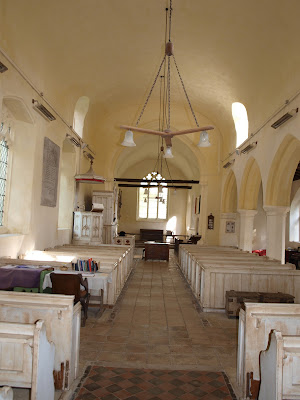St Andrew left me indifferent, even cold. The exterior is poor with an 1812 brick tower and a south aisle that was replaced at the same time and the interior is whitewashed with bleached pews and pulpit*. It does contain a rather fine unidentified monument but this has been savagely restored (almost to the extent of the Cutte monument at Arkesden) which rather spoils the effect.
* Another church needing a re-visit and a reappraisal.
ST ANDREW. Brick W tower of 1812, with pointed windows and battlements. C13 chancel with some renewed lancet windows. S aisle arcade mid C14 with massive octagonal piers and double-chamfered arches. The outer wall of the S aisle is largely of c. 1812. - FONT. Perp, octagonal, with traceried stem and the usual quatrefoils along the bowl. - BENCHES. Panels of bench-ends, also re-used in chancel stalls, pulpit etc. - PLATE. Cup of c. 1600; Paten on foot of 1699. - MONUMENT. Devereux Tallakarne d. 1627 and wife, epitaph of unusual design. No figures. Inscription and ornamental panels between termini caryatids. Tall obelisks and shield on top. The monument is a copy of that to Luce Tallakarne at Ashen.
* Another church needing a re-visit and a reappraisal.
ST ANDREW. Brick W tower of 1812, with pointed windows and battlements. C13 chancel with some renewed lancet windows. S aisle arcade mid C14 with massive octagonal piers and double-chamfered arches. The outer wall of the S aisle is largely of c. 1812. - FONT. Perp, octagonal, with traceried stem and the usual quatrefoils along the bowl. - BENCHES. Panels of bench-ends, also re-used in chancel stalls, pulpit etc. - PLATE. Cup of c. 1600; Paten on foot of 1699. - MONUMENT. Devereux Tallakarne d. 1627 and wife, epitaph of unusual design. No figures. Inscription and ornamental panels between termini caryatids. Tall obelisks and shield on top. The monument is a copy of that to Luce Tallakarne at Ashen.
HELIONS BUMPSTEAD. A small village with some fine old timbered houses, we remember its church as a symphony in green, green everywhere from the ivy outside to the pews, the pulpit, and the organ within. The chancel and its arch are 700 years old, and the nave may be older still, though it has a 16th century clerestory. A consecration cross is still on one of the buttresses. The south arcade is 14th century, but was altered in the Tudor Age, from which time comes a chest with three locks, and part of the south aisle roof. The font is 15th century, and so are a number of carved wooden panels to be seen about the church, on the door, on two modern benches, and on the beautiful pulpit. More fine old woodwork is in the fronts of the handsome chancel seats and in pews in the aisle, one of which has wonderful tracery with little hanging flowers and faces. By the font we found two benches of the 17th century, and altogether the old woodwork of this small place is its chief delight.
The full set can be seen here.



No comments:
Post a Comment